Microstructure and Mechanical Properties of Cu-CoatedCarbon-Nanotubes-Reinforced Aluminum Matrix Composites Fabricated by Ultrasonic-Assisted Casting
Abstract
1. Introduction
2. Materials and Methods
2.1. Original Materials
2.2. Experiment
2.2.1. Fabrication of Cu@CNTs
2.2.2. Fabrication of Intermediate Alloy
2.2.3. Fabrication of Cu@CNTs/ADC12 Composites
3. Result
4. Ultrasonic Cavitation Model
5. Discussion
5.1. Mechanism of Ultrasonic Action
5.2. Strengthening Mechanism of Cu@CNTs in the ADC12 Matrix
6. Summary
Author Contributions
Funding
Institutional Review Board Statement
Informed Consent Statement
Data Availability Statement
Conflicts of Interest
References
- Prakash, J.A.; Shanmughasundaram, P.; Sreelakshmy, P.S. Optimization of mechanical, tribological and machining parameters of aluminium MMC’s LM6 and ADC12. Mater. Today Proc. 2021, 37, 1996–2000. [Google Scholar] [CrossRef]
- Zhang, J.-D.; Zhang, L.; Ma, H.-Z. Effect of ZrO2 additions on the microstructure, mechanical and wear properties of ZrO2/7075 aluminium alloy composite. Mater. Today Commun. 2023, 37, 107437. [Google Scholar] [CrossRef]
- Okayasu, M.; Sahara, N.; Mayama, N. Effect of the microstructural characteristics of die-cast ADC12 alloy controlled by Na and Cu on the mechanical properties of the alloy. Mater. Sci. Eng. A 2022, 831, 142120. [Google Scholar] [CrossRef]
- Siengchin, S. A review on lightweight materials for defence applications: Present and future developments. Def. Technol. 2023, 24, 1–17. [Google Scholar] [CrossRef]
- Kuz’Min, M.; Kuz’Mina, M.; Kuz’Mina, A. Production and properties of aluminum-based composites modified with carbon nanotubes. Mater. Today Proc. 2019, 19, 1826–1830. [Google Scholar] [CrossRef]
- Liu, G.; Zhang, H.; Kan, D.; Tang, S.; Chen, Z. Experimental study on physical and mechanical properties and micro mechanism of carbon nanotubes cement-based composites. Fuller. Nanotub. Carbon Nanostruct. 2022, 30, 1252–1263. [Google Scholar] [CrossRef]
- Ouyang, Y.; Yang, Z.; Long, T.; Tian, H.; Bai, L.; Li, X.; Yuan, F. Preparation of branched Al2O3 and its synergistic effect with carbon nanotubes on the enhancement of thermal conductive and electrical insulation properties of silicone rubber composites. Mater. Today Commun. 2023, 34, 105239. [Google Scholar] [CrossRef]
- Čelko, L.; Menelaou, M.; Casas-Luna, M.; Horynová, M.; Musálek, T.; Remešová, M.; Díaz-De-La-Torre, S.; Morsi, K.; Kaiser, J. Spark plasma extrusion and the thermal barrier concept. Met. Mater. Trans. B 2019, 50, 656–665. [Google Scholar] [CrossRef]
- Chen, B.; Li, Z.; Shen, J.; Li, S.; Jia, L.; Umeda, J.; Kondoh, K.; Li, J. Mechanical properties and strain hardening behavior of aluminum matrix composites reinforced with few-walled carbon nanotubes. J. Alloys Compd. 2020, 826, 154075. [Google Scholar] [CrossRef]
- Dzidziguri, E.; Vasiliev, A.; Nalivaiko, A.Y.; Ozherelkov, D.Y.; Zakharova, N.; Shinkaryov, A.; Gromov, A. In-situ synthesis and characterization of powdery nanocomposite “carbon nanotubes/nanoalumina”. Compos. Commun. 2020, 22, 100534. [Google Scholar] [CrossRef]
- Li, N.Y.; Yang, C.; Li, C.J.; Guan, H.D.; Fang, D.; Tao, J.M.; Liu, Y.C.; Yi, J.H. Carbon nanotubes reinforced aluminum matrix composites with high elongation prepared by flake powder metallurgy. Diam. Relat. Mater. 2020, 107, 107907. [Google Scholar] [CrossRef]
- Perez-Bustamante, R.; Bueno- Escobedo, J.L.; Jimenez-Lobato, J.; Estrada-Guel, I.; Miki-Yoshida, M.; Licea-Jiménez, L.; Martínez-Sánchez, R. Wear behavior in Al2024-CNTs composites synthesized by mechanical alloying. Wear 2012, 292, 169–175. [Google Scholar] [CrossRef]
- He, C.; Zhao, N.; Shi, C.; Du, X.; Li, H.; Cui, Q. An approach to obtaining homogeneously dispersed carbon nanotubes in Al powders for preparing reinforced Al-Matrix composites. Adv. Mater. 2007, 19, 1128–1132. [Google Scholar] [CrossRef]
- Liu, S.-Y.; Gao, F.-P.; Zhang, Q.-Y.; Zhu, X.; Li, W.-Z. Fabrication of carbon nanotubes reinforced AZ91D composites by ultrasonic processing. Trans. Nonferrous Met. Soc. China 2010, 20, 1222–1227. [Google Scholar] [CrossRef]
- Mohammed, S.M.; Paul, T.; John, D.; Zhang, C.; Agarwal, A. Understanding the role of ultrasonic cavitation assisted casting of boron nitride nanotube-reinforced aluminum matrix composite. J. Mater. Res. Technol. 2023, 25, 2405–2418. [Google Scholar] [CrossRef]
- Srinivas, V.; Jayaraj, A.; Venkataramana, V.S.N.; Avinash, T.; Dhanyakanth, P. Effect of ultrasonic stir casting technique on mechanical and tribological properties of aluminium–multi-walled carbon nanotube nanocomposites. J. Bio- Tribo-Corros. 2020, 6, 30. [Google Scholar] [CrossRef]
- Ding, Y.; Jiang, H.; Wang, H.; Mao, D.; Zhang, Y.; Chen, Z.; Guo, X. Toughening and strengthening of Cu-coated carbon nanotubes reinforced AZ61 magnesium matrix nanocomposites by improving interfacial bonding. Diam. Relat. Mater. 2024, 142, 110788. [Google Scholar] [CrossRef]
- So, K.P.; Jeong, J.C.; Gil Park, J.; Park, H.K.; Choi, Y.H.; Noh, D.H.; Keum, D.H.; Jeong, H.Y.; Biswas, C.; Hong, C.H.; et al. SiC formation on carbon nanotube surface for improving wettability with aluminum. Compos. Sci. Technol. 2013, 74, 6–13. [Google Scholar] [CrossRef]
- Zhao, J.W.; Wu, S.S.; An, P.; Mao, Y.W. Preparation of semi-solid slurry of hypereutectic al-si alloy by ultrasonic vibration. Solid State Phenom. 2008, 141–143, 767–771. [Google Scholar] [CrossRef]
- Zeng, M.; Yan, H.; Li, K.; Lei, Y. Microstructure, wettability, and mechanical properties of ADC12 alloy reinforced with TiO2-coated carbon nanotubes. J. Alloys Compd. 2021, 897, 163181. [Google Scholar] [CrossRef]
- Zeng, M.; Wang, X.X.; Tan, Z.H.; Huang, X.X.; Wang, J.N. Remarkable durability of Pt–Ir alloy catalysts supported on graphitic carbon nanocages. J. Power Sources 2014, 264, 272–281. [Google Scholar] [CrossRef]
- Tang, Y.; Yang, X.; Wang, R.; Li, M. Enhancement of the mechanical properties of graphene–copper composites with graphene–nickel hybrids. Mater. Sci. Eng. A 2014, 599, 247–254. [Google Scholar] [CrossRef]
- Orel, Z.C.; Anžlovar, A.; Dražić, G.; Žigon, M. Cuprous Oxide Nanowires Prepared by an Additive-Free Polyol Process. Cryst. Growth Des. 2007, 7, 453–458. [Google Scholar] [CrossRef]
- Mishra, S.R. Ahmaruzzaman CuO and CuO-based nanocomposites: Synthesis and applications in environment and energy. Sustain. Mater. Technol. 2022, 33, 463. [Google Scholar] [CrossRef]
- Esawi, A.; Morsi, K.; Sayed, A.; Gawad, A.A.; Borah, P. Fabrication and properties of dispersed carbon nanotube–aluminum composites. Mater. Sci. Eng. A 2009, 508, 167–173. [Google Scholar] [CrossRef]
- George, R.; Kashyap, K.; Rahul, R.; Yamdagni, S. Strengthening in carbon nanotube/aluminium (CNT/Al) composites. Scr. Mater. 2005, 53, 1159–1163. [Google Scholar] [CrossRef]
- Wang, Y.; Guo, Q.; Ren, N.; Zhang, W.; Hu, S.; Zhang, Y.; Li, J.; Xia, M.; Li, J. Experimental and simulation studies of layer casting on industrial-scale Al-4.5 wt Pct Cu ingot: Effect, defect, and optimization. J. Mater. Process. Technol. 2023, 322, 118205. [Google Scholar] [CrossRef]
- Dong, X.; Wang, Y.; Xu, L.; Liu, Z.; Yan, H. Effect of high-energy ultrasound and mixed rare earths modification on microstructure of semisolid AlSi11Cu3 alloy. Int. J. Met. 2023, 17, 1191–1200. [Google Scholar] [CrossRef]
- Hedayat, A.; Davari, A. Feasibility study to increase the reactor power at natural convection mode in tehran research reactor (TRR) through a hybrid thermal-hydraulic simulation and analysis using the RELAP5 code and computational fluid dynamic (CFD) modeling by ANSYS-FLUENT. Prog. Nucl. Energy 2022, 150, 104285. [Google Scholar] [CrossRef]
- Haghayeghi, R.; Ezzatneshan, E.; Bahai, H. Grain refinement of AA5754 aluminum alloy by ultrasonic cavitation: Experimental study and numerical simulation. Met. Mater. Int. 2015, 225, 103–109. [Google Scholar] [CrossRef]
- Jian, X.; Han, Q. Formation of hypereutectic silicon particles in hypoeutectic Al-Si alloys under the influence of high-intensity ultrasonic vibration. China Foundry 2013, 10, 118. [Google Scholar] [CrossRef]
- Heydari, S.; Sajjadi, S.A.; Babakhani, A.; Eskandari, H.; Nateq, B. An investigation on the effect of Al4C3 on microstructure and mechanical properties of carbon nanotube reinforced aluminum composite. Ceram. Int. 2023, 49, 14024–14034. [Google Scholar] [CrossRef]
- Murugesan, R.; Gopal, M.; Murali, G. Effect of Cu, Ni addition on the CNTs dispersion, wear and thermal expansion behavior of Al-CNT composites by molecular mixing and mechanical alloying. Appl. Surf. Sci. 2019, 495, 143542. [Google Scholar] [CrossRef]
- Pérez-Bustamante, R.; Pérez-Bustamante, F.; Estrada-Guel, I.; Licea-Jiménez, L.; Miki-Yoshida, M.; Martínez-Sánchez, R. Effect of milling time and CNT concentration on hardness of CNT/Al2024 composites produced by mechanical alloying. Mater. Charact. 2013, 75, 13–19. [Google Scholar] [CrossRef]
- Lee, C.W.; Kim, I.H.; Lee, W.; Ko, S.H.; Jang, J.M.; Lee, T.W.; Lim, S.H.; Park, J.P.; Kim, J.D. Formation and analysis of SiC coating layer on carbon short fiber. Surf. Interface Anal. 2010, 42, 1231–1234. [Google Scholar] [CrossRef]
- Zhou, W.; Sasaki, S.; Kawasaki, A. Effective control of nanodefects in multiwalled carbon nanotubes by acid treatment. Carbon 2014, 78, 121–129. [Google Scholar] [CrossRef]
- Yuan, Q.H.; Zeng, X.S.; Wang, Y.C.; Luo, L.; Ding, Y.; Li, D.J.; Liu, Y. Microstructure and mechanical properties of Mg-4.0Zn alloy reinforced by NiO-coated CNTs. J. Mater. Sci. Technol. 2017, 33, 452–460. [Google Scholar] [CrossRef]
- Zeng, M.; Ling, Y.; Zhang, P.X.; Dong, X.J.; Li, K.; Yan, H. Improvement of interfacial interaction and mechanical properties in aluminum matrix composites reinforced with Cu-coated carbon nanotubes. Mater. Sci. Eng. A 2023, 870, 144918. [Google Scholar] [CrossRef]

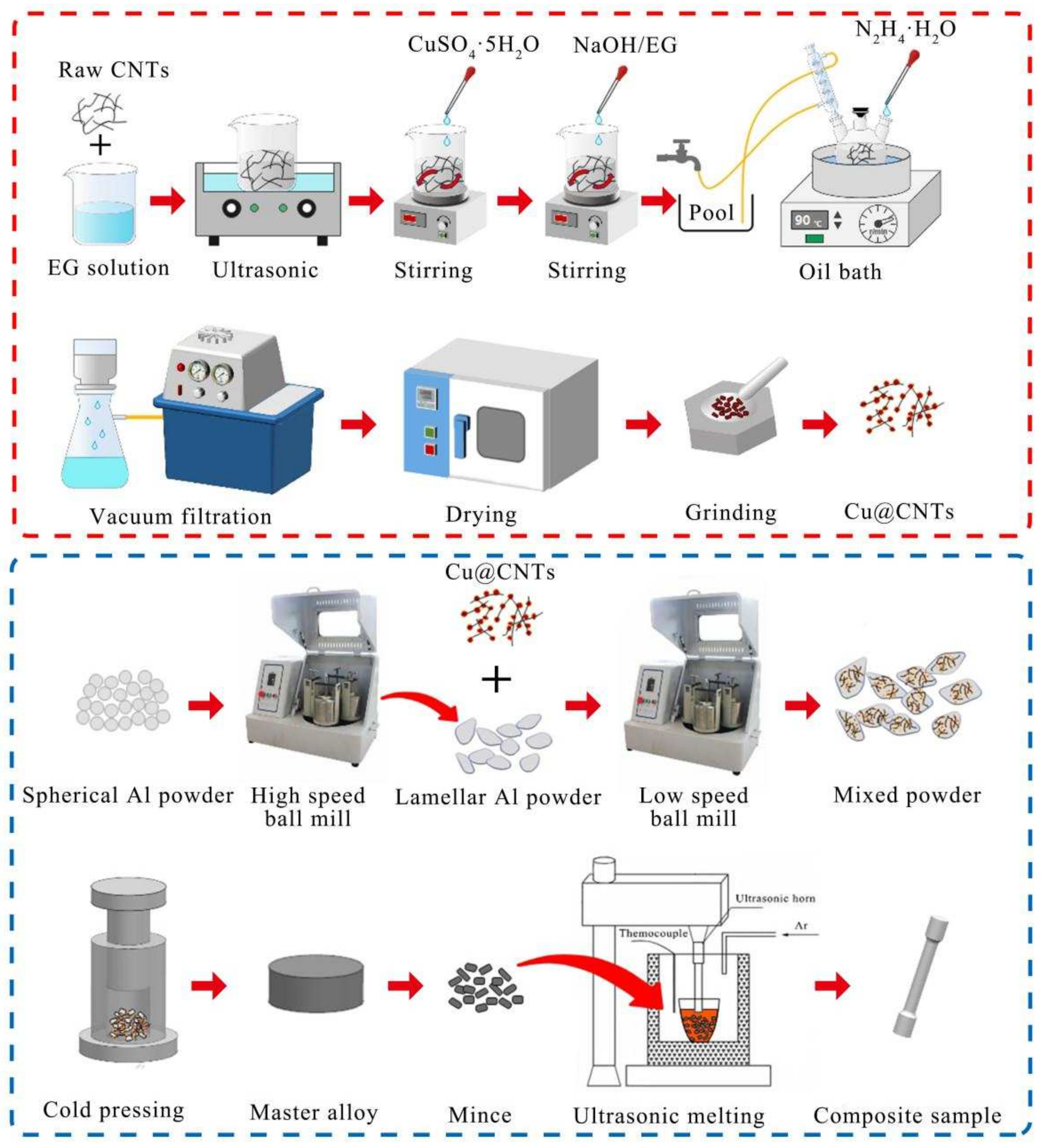




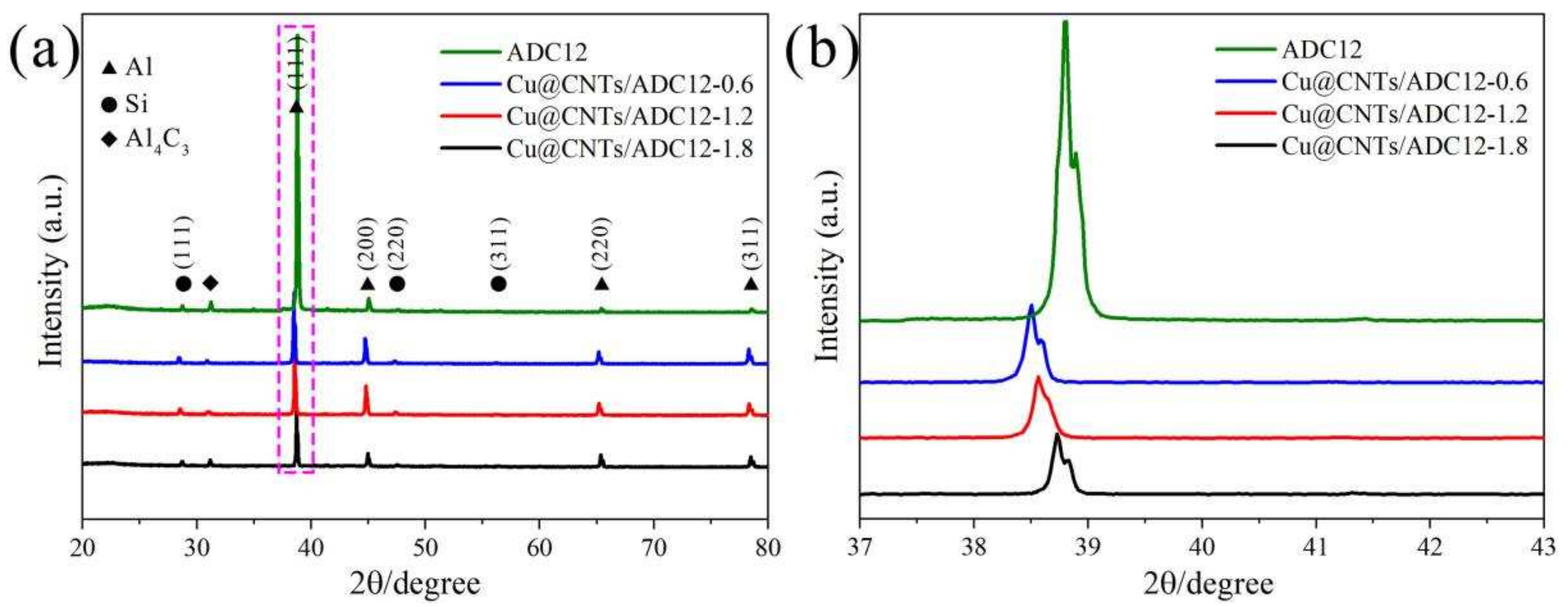
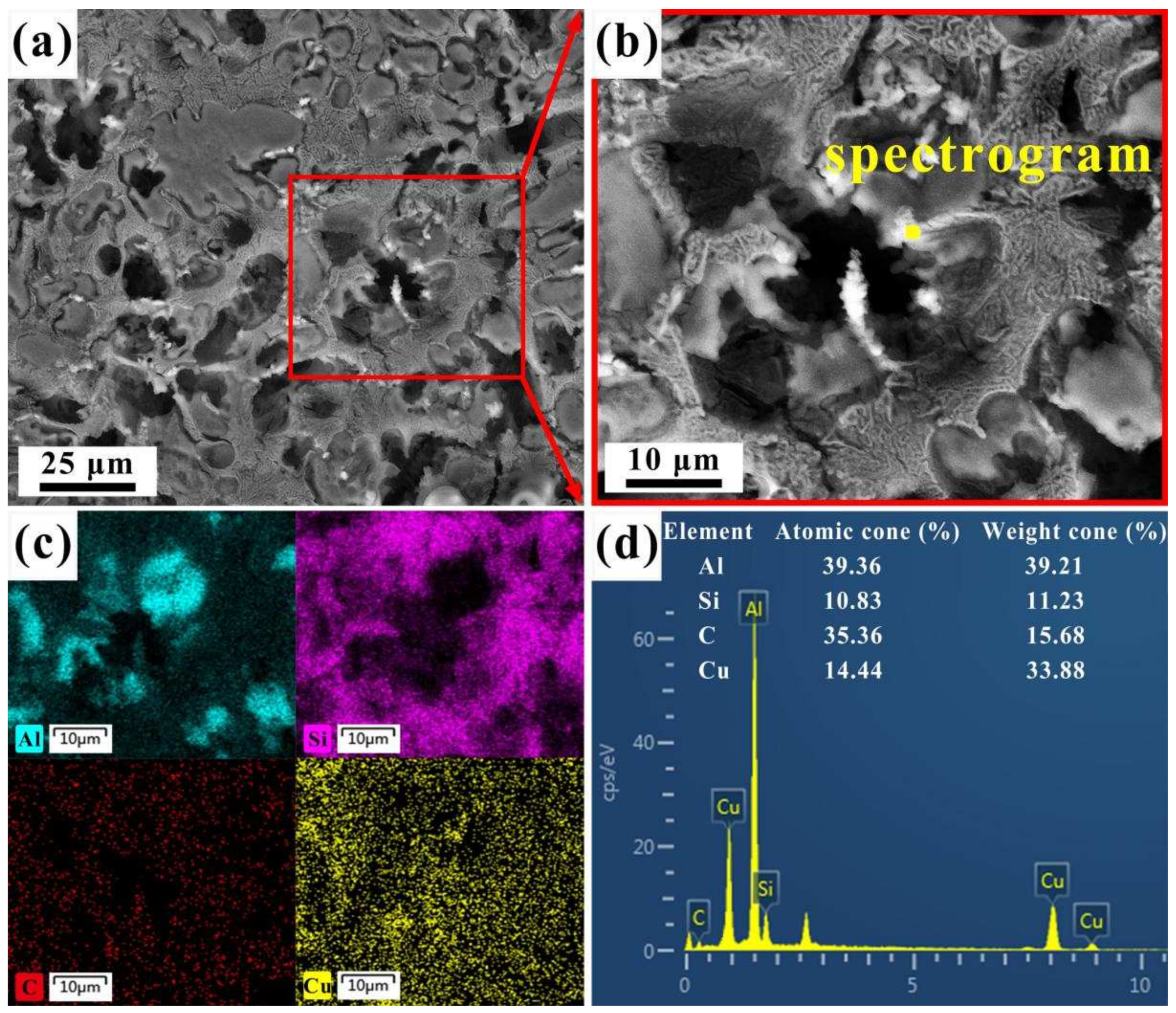



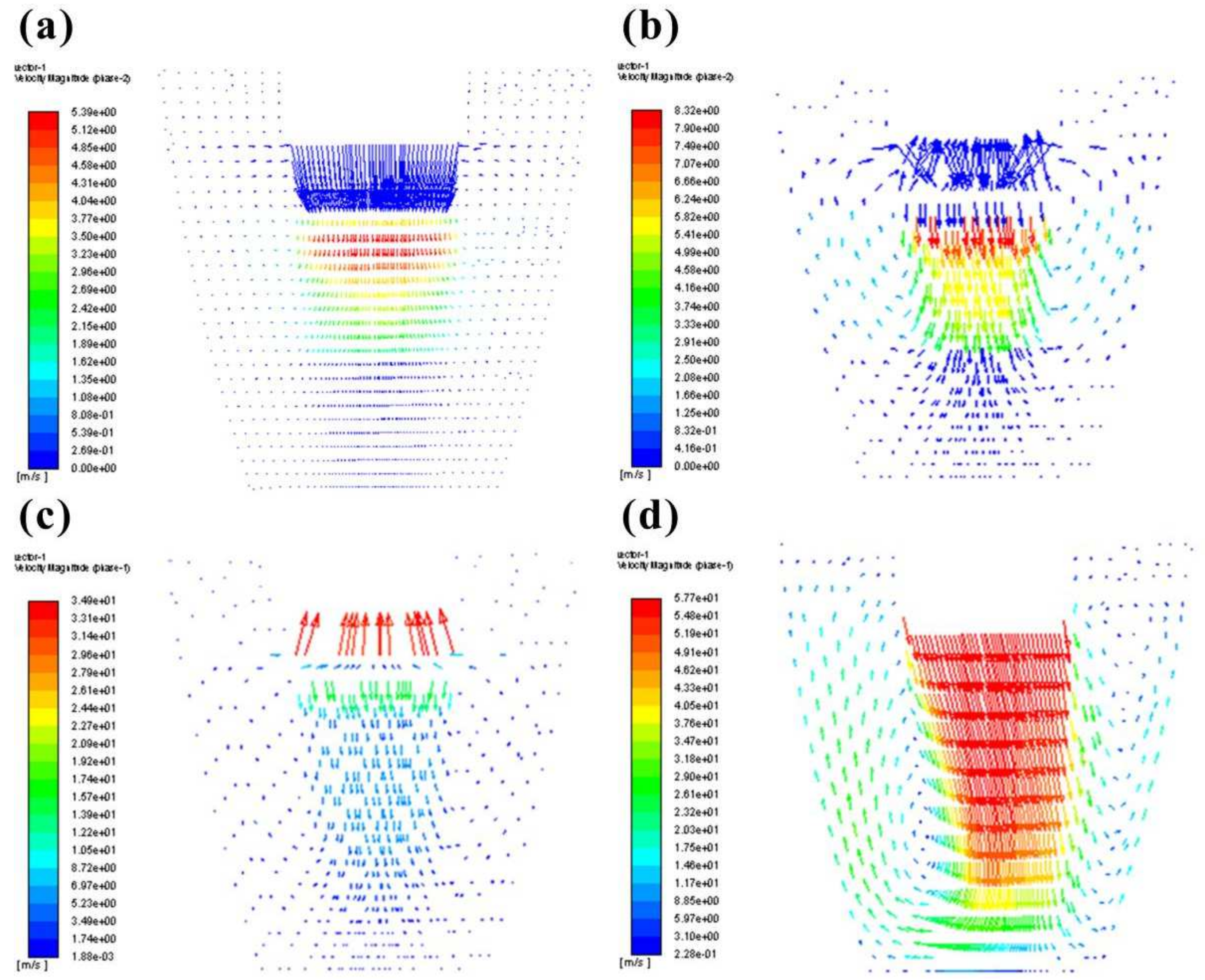
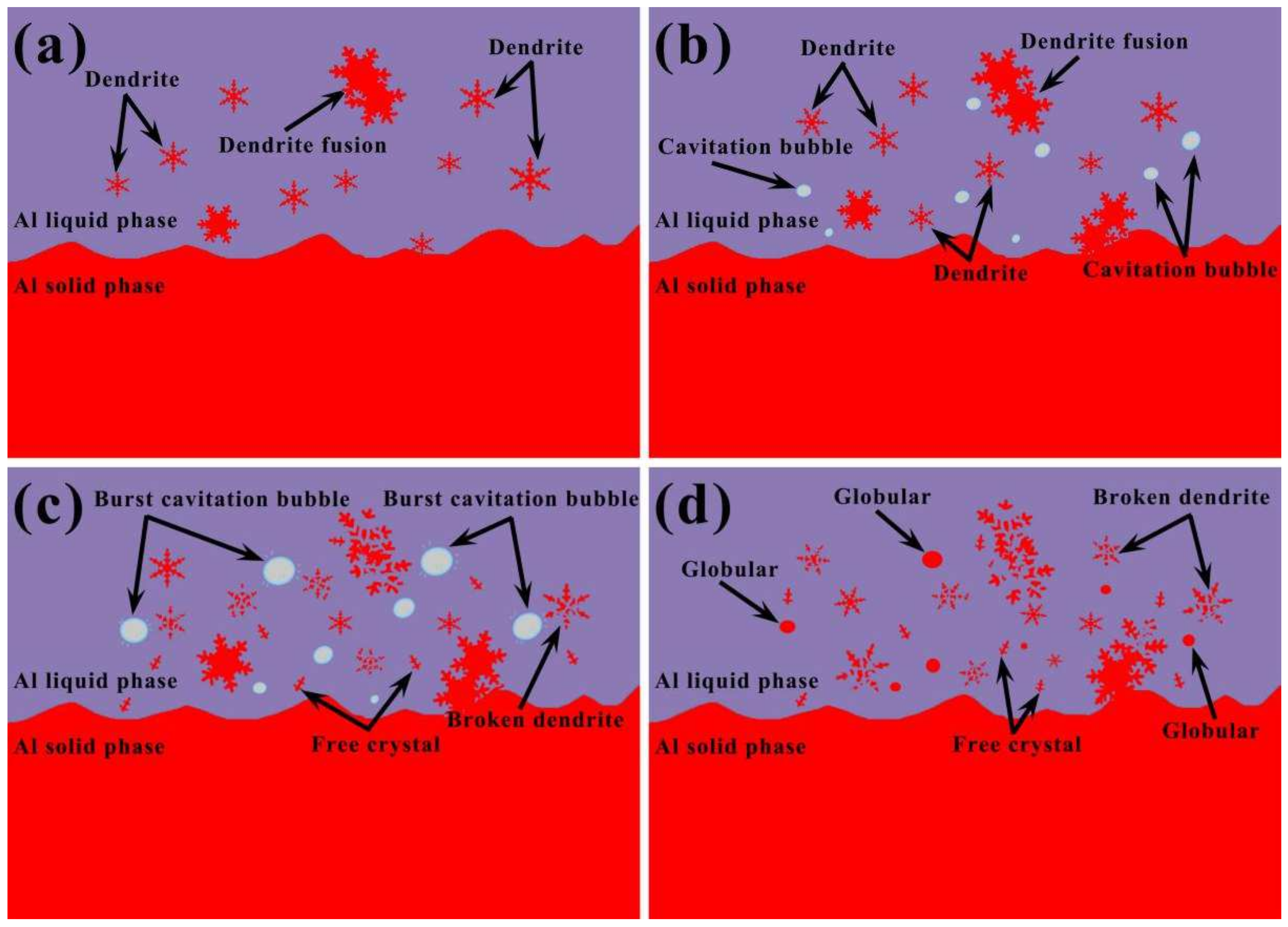
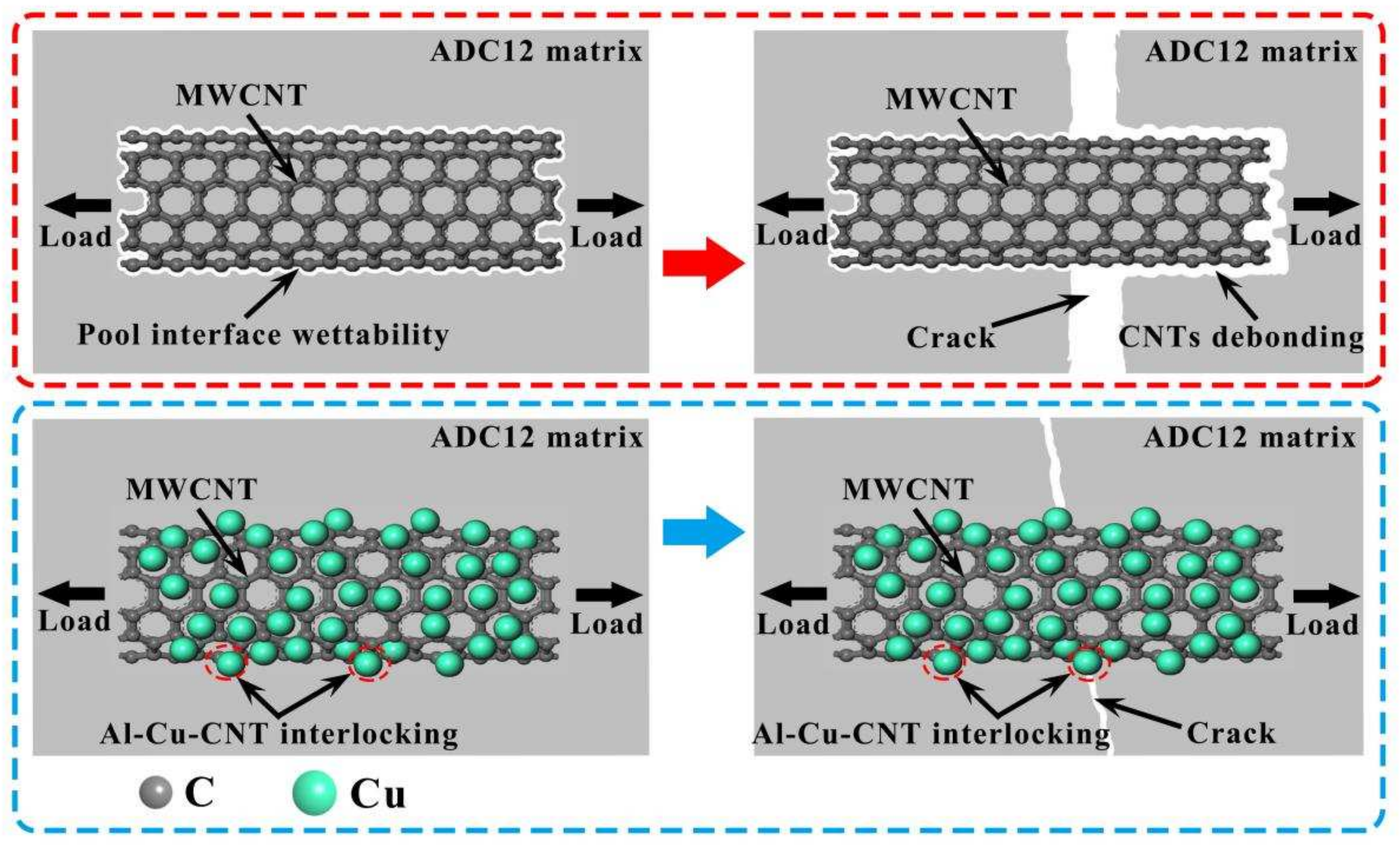
| Element | Al | Si | Cu | Mg | Fe | Mn | Zn |
|---|---|---|---|---|---|---|---|
| Content (wt%) | Bal. | 10.75 | 2.84 | 0.21 | 0.82 | 0.26 | 0.64 |
| Sample | Yield Strength (MPa) | Ultimate Tensile Strength (MPa) | Elongation (%) |
|---|---|---|---|
| ADC12 | 145.3 | 202.6 | 3.50 |
| Cu@CNT/ADC12-0.6 | 190.2 | 270.4 | 3.62 |
| Cu@CNT/ADC12-1.2 | 202.2 | 310.3 | 3.70 |
| Cu@CNT/ADC12-1.8 | 182.6 | 240.6 | 3.22 |
Disclaimer/Publisher’s Note: The statements, opinions and data contained in all publications are solely those of the individual author(s) and contributor(s) and not of MDPI and/or the editor(s). MDPI and/or the editor(s) disclaim responsibility for any injury to people or property resulting from any ideas, methods, instructions or products referred to in the content. |
© 2024 by the authors. Licensee MDPI, Basel, Switzerland. This article is an open access article distributed under the terms and conditions of the Creative Commons Attribution (CC BY) license (https://creativecommons.org/licenses/by/4.0/).
Share and Cite
Dong, X.; Zeng, M.; Yan, H. Microstructure and Mechanical Properties of Cu-CoatedCarbon-Nanotubes-Reinforced Aluminum Matrix Composites Fabricated by Ultrasonic-Assisted Casting. Metals 2024, 14, 265. https://doi.org/10.3390/met14030265
Dong X, Zeng M, Yan H. Microstructure and Mechanical Properties of Cu-CoatedCarbon-Nanotubes-Reinforced Aluminum Matrix Composites Fabricated by Ultrasonic-Assisted Casting. Metals. 2024; 14(3):265. https://doi.org/10.3390/met14030265
Chicago/Turabian StyleDong, Xiaojian, Min Zeng, and Hong Yan. 2024. "Microstructure and Mechanical Properties of Cu-CoatedCarbon-Nanotubes-Reinforced Aluminum Matrix Composites Fabricated by Ultrasonic-Assisted Casting" Metals 14, no. 3: 265. https://doi.org/10.3390/met14030265
APA StyleDong, X., Zeng, M., & Yan, H. (2024). Microstructure and Mechanical Properties of Cu-CoatedCarbon-Nanotubes-Reinforced Aluminum Matrix Composites Fabricated by Ultrasonic-Assisted Casting. Metals, 14(3), 265. https://doi.org/10.3390/met14030265





